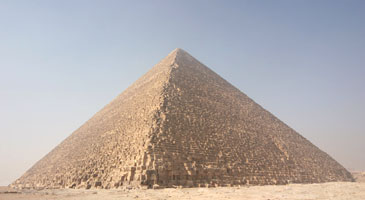 The Seven Wonders of the World are described by historians and others as a list of man-made structures created during the Classical era. Although there are now “new” Seven Wonders of the World lists, most would agree that these are the most prominent. The one that many think of first is the Great Pyramid of Giza which is located in Egypt and is the only remaining structure of the seven. This is the largest of three pyramids in Giza standing at 480 feet high and believed to have taken twenty years to build.
The Seven Wonders of the World are described by historians and others as a list of man-made structures created during the Classical era. Although there are now “new” Seven Wonders of the World lists, most would agree that these are the most prominent. The one that many think of first is the Great Pyramid of Giza which is located in Egypt and is the only remaining structure of the seven. This is the largest of three pyramids in Giza standing at 480 feet high and believed to have taken twenty years to build.
Unfortunately, the other six were destroyed by various means. The Hanging Gardens of Babylon is considered significant due to its complex irrigation system. There is still a question if there were really “gardens” but there is evidence of vaulted terraces supported on pillars – “an artificial rising mountain of gardens.” This was destroyed by an earthquake around the first century B.C.
The Temple of Artemis at Ephesus in Turkey was built to honor the Greek goddess of hunting and nature. This completely marble structure was destroyed by arson. The Greek god, Zeus, was also honored with a statue at Olympia in Greece. He is seated and holds a statue of Nike, goddess of victory. Historians disagree on how it was demolished. A third god was recognized through the Colossus at Rhodes. It was a 100 foot statue erected of Helios, the patron saint of the island of Rhodes. An earthquake destroyed it only 54 years after it was built.
The Tomb of Maussollos at Halicarnassus was constructed to honor the king, Maussollos, and his wife. Many statues and columns decorated the exterior but all was lost due to several earthquakes in the 14th century. The Lighthouse of Alexandria on the Pharos Island in Egypt used light color stone and a mirror was placed at its highest point to reflect sunlight during the day. Two earthquakes damaged it in the early 1330’s and the rest was destroyed in 1480 when a fort was built there.
So what is the relevance in today’s world? Obviously some of the uniqueness and innovativeness of these structures were quite impressive, however, it goes well beyond that. These structures took many years to erect and some of the key people did not live long enough to see their creations come to fruition. They still were patient and dedicated to their mission and that is what most business leaders lack today. Many of today’s executives are looking for the quick fix – some want to appease Wall Street and their investors, some are ego driven, some are just clueless on how to develop and execute a well thought out plan, and others do not build an organization on trust and loyalty.
Regardless of the reason, it is important for those working in companies where they feel underappreciated and/or the company is looking like it is going down the wrong path to stop and think “is this what I want to be associated with? Is the money, prestige, etc. all worth it? Do the company’s values and mission, if it even exists, align with my core values?” If the answer is “no”, this is a good time to take stock and develop your own plan on where you want to work. Just like the Seven Wonders of the World, it is imperative to have a vision, develop a comprehensive plan, and be dedicated to see it through to completion.
To start, determine your core values which I describe as the foundation of your house. Next determine what steps (stairs) need to be taken to reach your goals. The roof is your ultimate goal(s). There may be windows in your house that take you down other paths or open your eyes to other possibilities, so you need to really discern if they are viable options to get you to the roof. One more thing, to keep you on track, print out a picture of what you are looking to achieve, or if nothing else, get a photo of one the Seven Wonders of the World to remind yourself that you want to have a fulfilling career and life, and that you deserve it.
